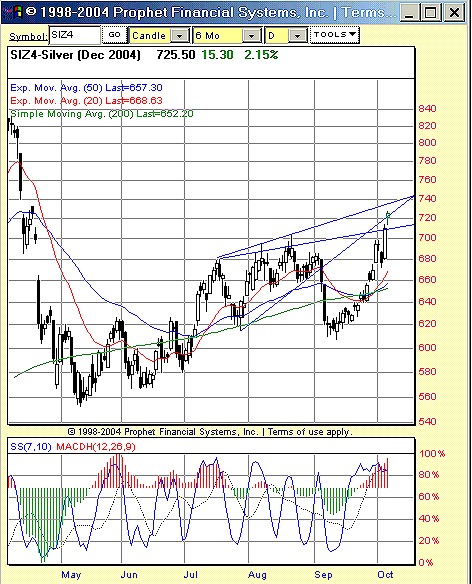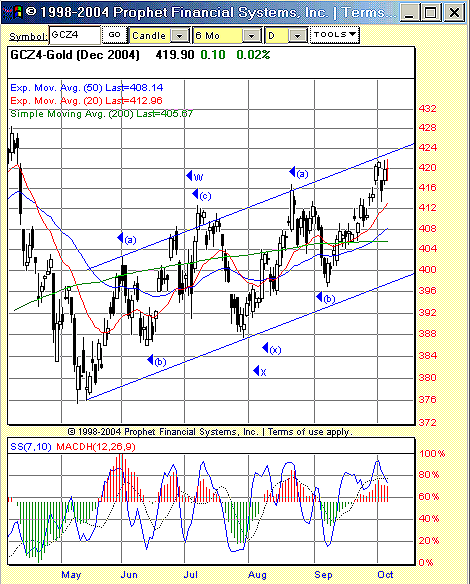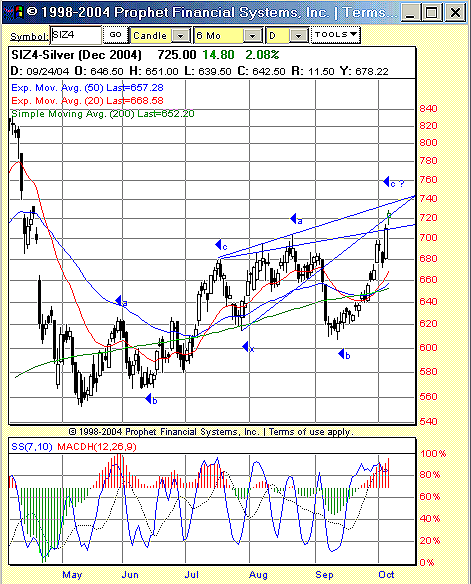
HOT TOPICS LIST
- MACD
- Fibonacci
- RSI
- Gann
- ADXR
- Stochastics
- Volume
- Triangles
- Futures
- Cycles
- Volatility
- ZIGZAG
- MESA
- Retracement
- Aroon
INDICATORS LIST
LIST OF TOPICS
PRINT THIS ARTICLE
by David Penn
With a completed breakdown from a rising wedge, silver has moved to multimonth highs. Does that make it time to turn bullish?
Position: N/A
David Penn
Technical Writer for Technical Analysis of STOCKS & COMMODITIES magazine, Working-Money.com, and Traders.com Advantage.
PRINT THIS ARTICLE
ELLIOTT WAVE
Silver: Up For The Downstroke?
10/07/04 09:30:48 AMby David Penn
With a completed breakdown from a rising wedge, silver has moved to multimonth highs. Does that make it time to turn bullish?
Position: N/A
| In a recent piece for Traders.com Advantage, I made a bearish case for silver futures ("So Long Silver," Traders.com Advantage, September 22). This case stemmed in part from my series on the bearish case for gold that appeared in two parts in Working-Money.com ("Gold's Last Gasp?" Working-Money.com, September 22 and 29). |
| Veteran traders and technical analysts always insist that we find a spot that, if reached, will let us know as unequivocally as possible that the present analysis, the prevailing assumption, is wrong. Call it your "uncle" point, your "tap-out" point, your "eject" button ... the idea remains the same, and moreover is one of the cornerstones of trade management. To steal from the old Anheuser-Busch ad campaign, "Know when to say when." |

|
| Figure 1: Silver, December 2004 contract. As soon as silver prices reached the bottom of the rising wedge formation, they rallied sharply, setting a new multimonth high in about 30 days. |
| Graphic provided by: Prophet Financial Systems. |
| |
| The "when" point in my bearish stance on silver arrived yesterday, as silver prices bounded up to set new multimonth highs above $7. In my most recent piece on silver, I looked for a resumption of the bear market that made itself known back in April of this year. More specifically, I thought that silver in late August and into September was beginning an impulse leg down. Such an impulse leg should have taken silver down to year-to-date lows without a major retracement that would violate recent minor highs, such as the end of August/end of September mini-peak. When silver futures did in fact violate that high, I knew there was cause for concern among the bears. When the August highs were taken out, it became clear that even if silver wanted to move lower (which I still believe it does), it does not want to do so yet. Recent price action actually has silver more and more resembling gold. My previous article implied that silver was a bit ahead of gold by a price swing or two. The failure of silver to break down and, instead, to set a new, multimonth high makes the silver chart and the gold chart look interestingly similar--especially since the May lows. |
My previous analysis of silver did not include a wave count--one that contributed to my bearish outlook. The similarities between silver and gold at present are such that the wave count provided for gold in Figure 2 is identical to my silver count in all important respects. As such, the September rally observable in both gold and silver looks like the final upleg in a double three pattern (abcXabc or WXY). A double three is a complex corrective pattern often reflective of a great deal of distribution (when occurring in a bullish second wave, at least) and can consist of a number of combinations of smaller corrective patterns such as flats, zigzags, and triangles. Figure 2: Is it silver or gold? This chart of December gold futures resembles the chart of December silver futures -- and begs the question of whether the bearish projection for gold will turn out to be suggestive of what might be in store for silver. |
If this is the case, that silver is unwinding in a corrective double three, then how much higher might this correction run? One method is to assume that the first three (also called the "W" from the May lows to the July highs) will be the same size as the second three (also called the "Y" from the July lows to the October highs). If this were to be the case in this instance, the first three is approximately 1.2. Adding this amount to the July lows gives us a "Y" or second three that tops near the 7.48 level. Another approach is to assume that as the "third wave" (as in "W," then "X," then "Y"), the second three might actually be larger than the initial three. In this case, using a Fibonacci multiple such as 1.618 and multiplying that amount by the size of the first three (1.2) gives us a "Y" upside to 8.23. Figure 3: The double three. The double three corrective pattern in silver increasingly resembles the double three corrective pattern in gold. In either scenario, silver might not have much more upside, but there may still be money to be made by casting your trading lot with the silver bulls. |
Technical Writer for Technical Analysis of STOCKS & COMMODITIES magazine, Working-Money.com, and Traders.com Advantage.
| Title: | Technical Writer |
| Company: | Technical Analysis, Inc. |
| Address: | 4757 California Avenue SW |
| Seattle, WA 98116 | |
| Phone # for sales: | 206 938 0570 |
| Fax: | 206 938 1307 |
| Website: | www.Traders.com |
| E-mail address: | DPenn@traders.com |
Traders' Resource Links | |
| Charting the Stock Market: The Wyckoff Method -- Books | |
| Working-Money.com -- Online Trading Services | |
| Traders.com Advantage -- Online Trading Services | |
| Technical Analysis of Stocks & Commodities -- Publications and Newsletters | |
| Working Money, at Working-Money.com -- Publications and Newsletters | |
| Traders.com Advantage -- Publications and Newsletters | |
| Professional Traders Starter Kit -- Software | |
Click here for more information about our publications!
Comments
Date: 10/11/04Rank: 2Comment:

|

Request Information From Our Sponsors
- VectorVest, Inc.
- Executive Premier Workshop
- One-Day Options Course
- OptionsPro
- Retirement Income Workshop
- Sure-Fire Trading Systems (VectorVest, Inc.)
- Trading as a Business Workshop
- VectorVest 7 EOD
- VectorVest 7 RealTime/IntraDay
- VectorVest AutoTester
- VectorVest Educational Services
- VectorVest OnLine
- VectorVest Options Analyzer
- VectorVest ProGraphics v6.0
- VectorVest ProTrader 7
- VectorVest RealTime Derby Tool
- VectorVest Simulator
- VectorVest Variator
- VectorVest Watchdog
- StockCharts.com, Inc.
- Candle Patterns
- Candlestick Charting Explained
- Intermarket Technical Analysis
- John Murphy on Chart Analysis
- John Murphy's Chart Pattern Recognition
- John Murphy's Market Message
- MurphyExplainsMarketAnalysis-Intermarket Analysis
- MurphyExplainsMarketAnalysis-Visual Analysis
- StockCharts.com
- Technical Analysis of the Financial Markets
- The Visual Investor
